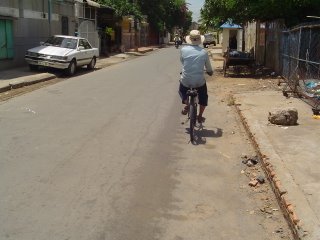Much the same applied to the ‘big smoke’, Cambodia’s capital city, Phnom Penh. Crossing Cambodia first visited the place back in 2002. Back then there were very few blacktopped roads, only the main grid. Most, if not all side roads, were dusty affairs. Positively, this has changed: near the main city center many of these side roads have or are being upgraded. There does seem to be a positive correlation between the wealth of the businesses/residential properties and the amount of blacktopping. Let’s call it a coincidence.
 In 2002, street 278 was unpaved, now in tip-top condition
In 2002, street 278 was unpaved, now in tip-top conditionSadly, some roads are falling into disrepair. They potholes are resulting in dangerous situations, especially now in the rainy season. Puddles disguise the depth of the hole, much to the distress of two-wheelers.
 The unpaved street 282
The unpaved street 282The unpaved roads, present their own problems. As Cambodians have a luck-luster affair with garbage collection, the roads tend to incorporate a certain degree of refuse. Additionally due to the real-estate renovation boom, small amounts of debris are added, however mostly broken bricks, not the more obvious dirt. All-in-all, this makes careful driving on Phnom Penh’s unpaved roads required. The dry season then has the added problem of dust from the unpaved roads, mostly produced by speeding cars, not so nice for other road users or local inhabitants. But that is not the problem of the driver, simply the problem of Phnom Penh’s roads’ co-user.
 Great pot-holing on street 63!
Great pot-holing on street 63!